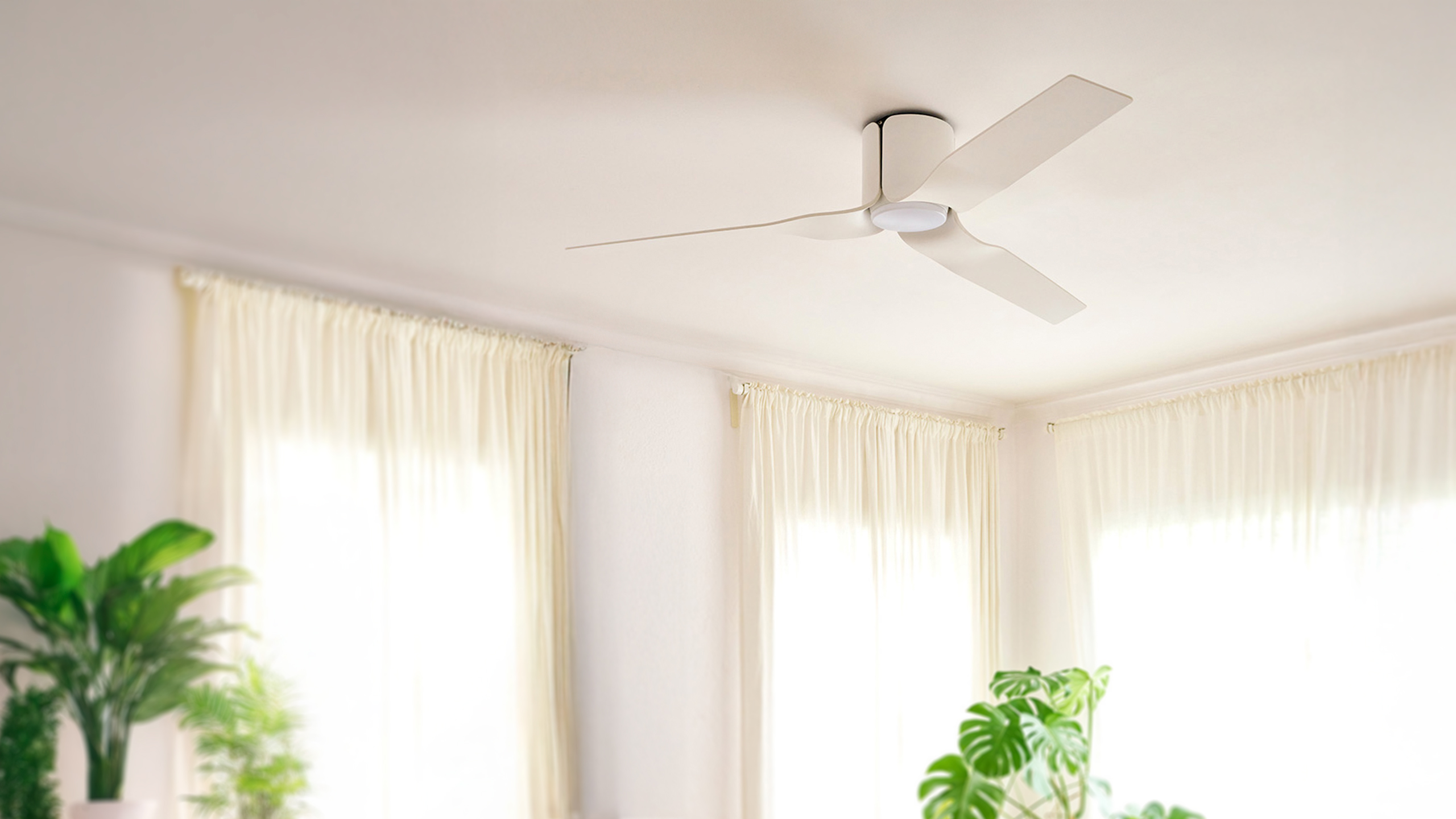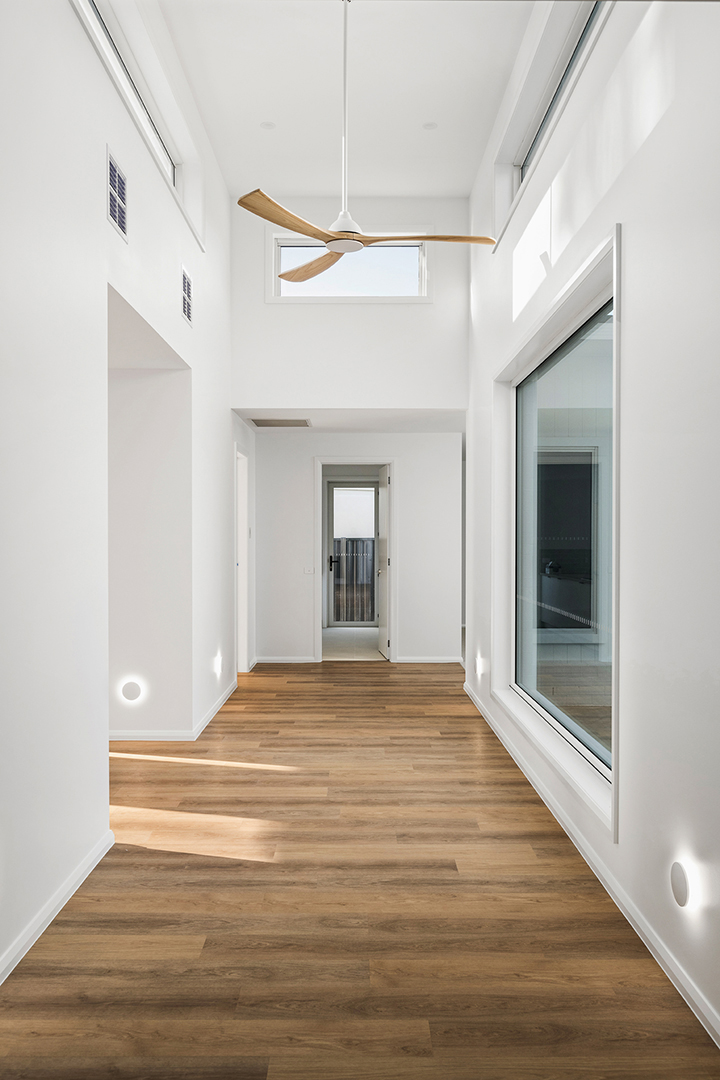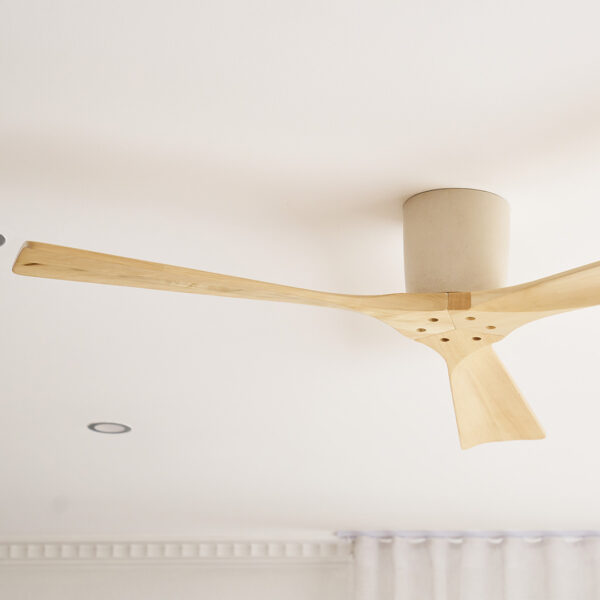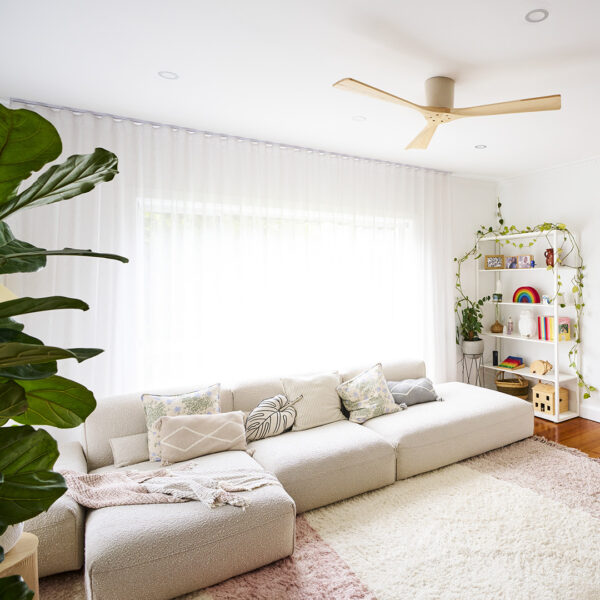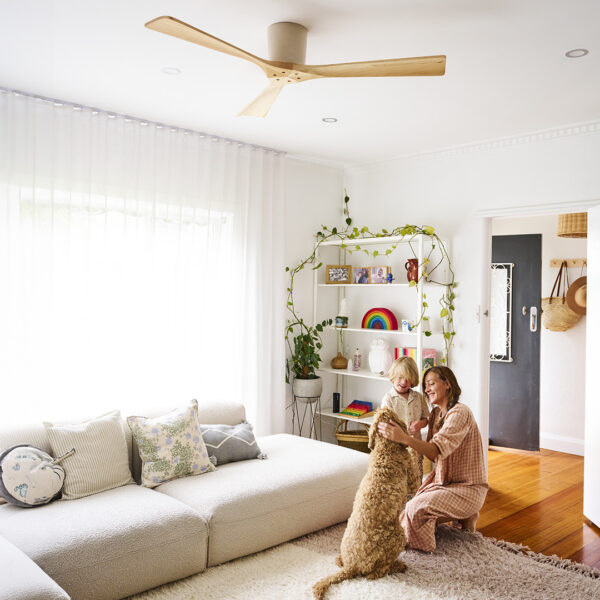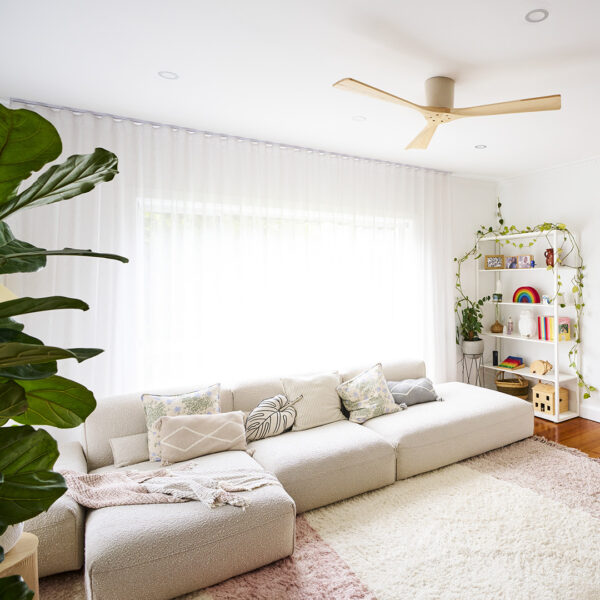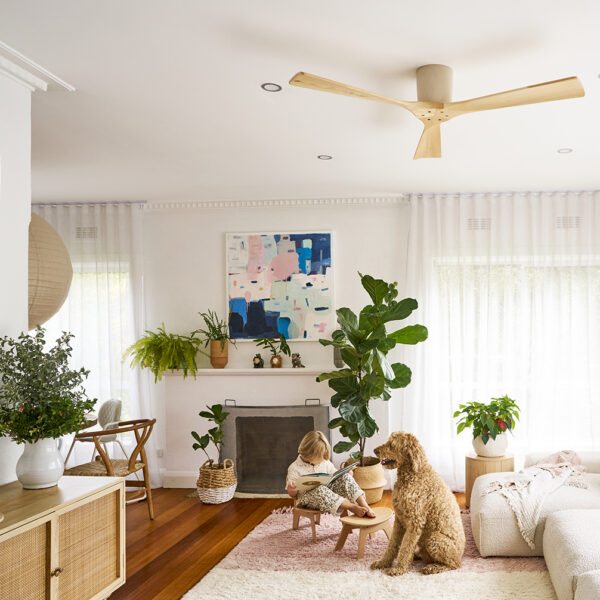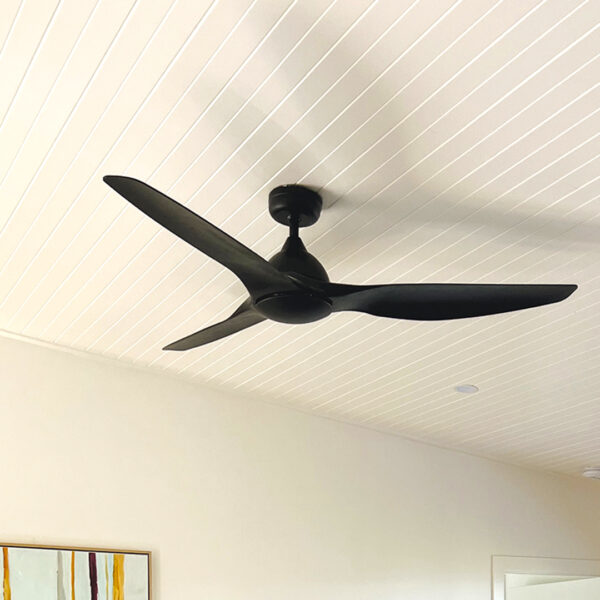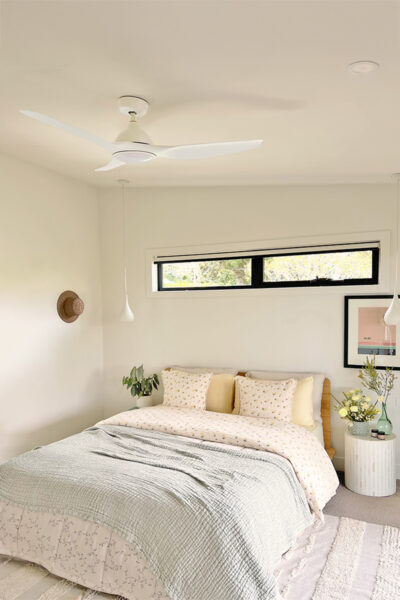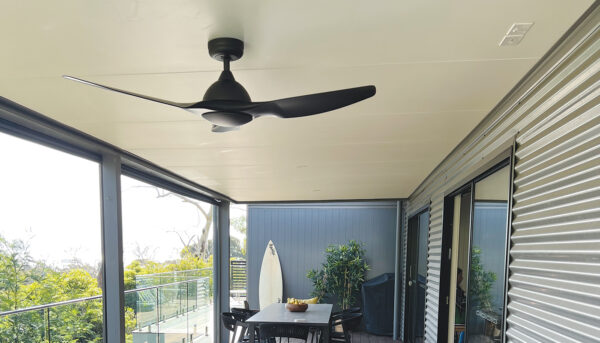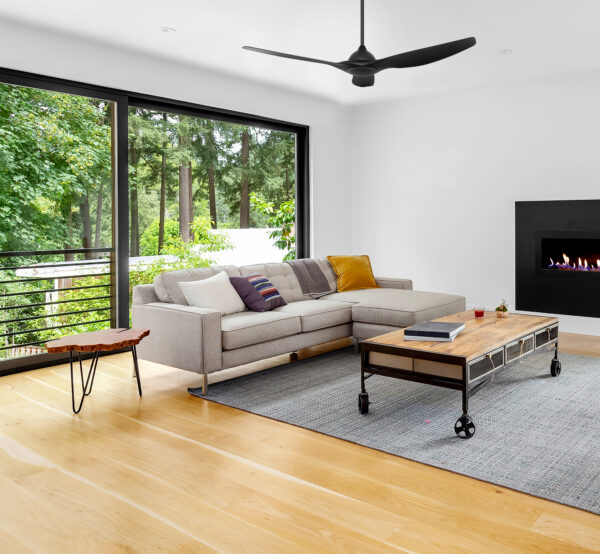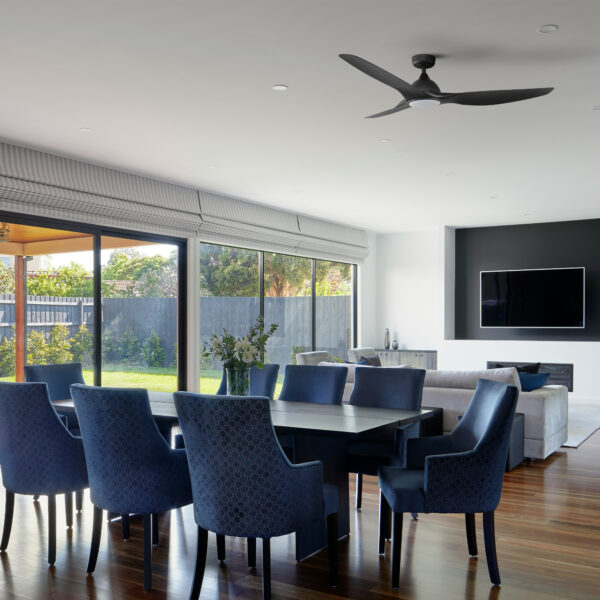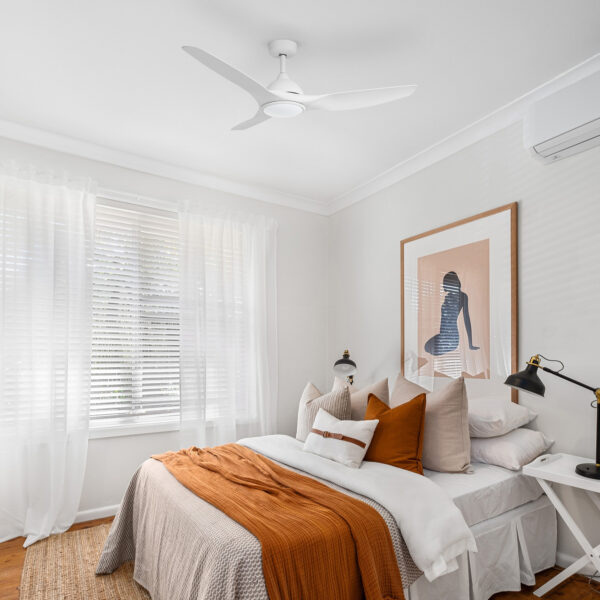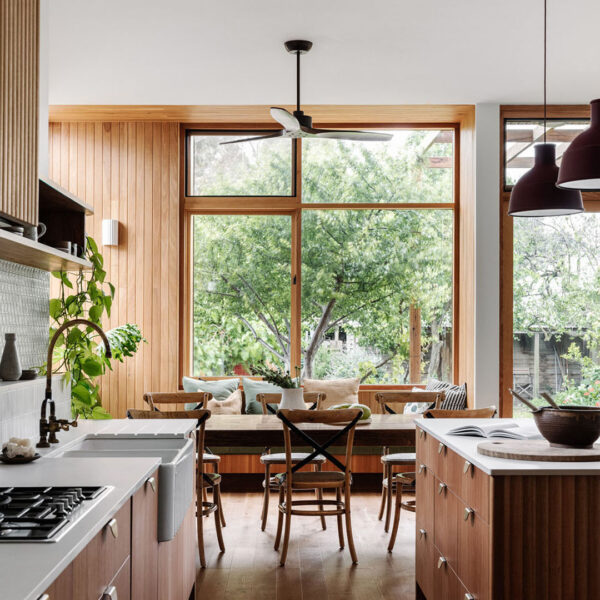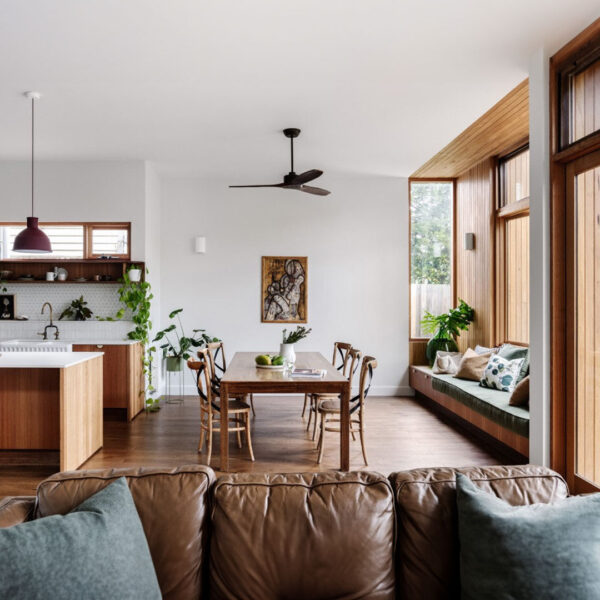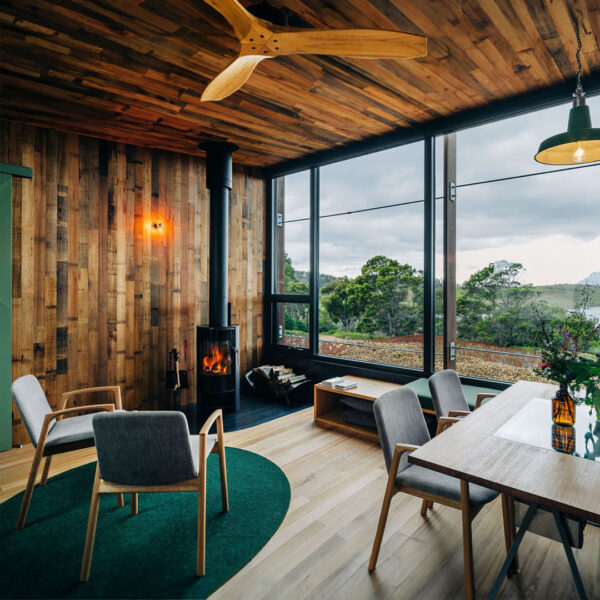The Case for Running Ceiling Fans Around the Clock
-
Yes, ceiling fans are designed for continuous operation, an can be left to run on their own for days-weeks at a time.
-
Ceiling fans are highly energy efficient, particularly DC ceiling fans which use very little electricity with even their high-power operations.
-
There are actually many advantages to leaving your fan run continuously.
-
Continuous fan operation helps support indoor thermal comfort all year round.
-
Continuous 24/7 air circulation actually has many positives, such as helping control humidity and reduce moisture build-up, supporting indoor ventilation and improving air quality by circulating fresh air, and helping disperse odours from cooking, pets or daily activities.
-
Ceiling fans enhance the effectiveness of air conditioning and heating systems through supporting them with additional airflow.
“Should I leave the fan running?”
The Common Concern for Fan Owners.
As our relationship with the home evolves, so do our expectations around indoor comfort. With many Australians spending more time working from home and actively trying to reduce energy consumption, there’s a growing curiosity around how to make existing appliances work harder, smarter, and more sustainably. Ceiling fans have long been considered a supplementary tool for heating and cooling, but today they are emerging as essential components in creating efficient, healthy indoor environments thanks to their low energy use and year-round functionality. They have become key players in supporting modern, sustainable living and modern fan design reflects this by being built to operate continuously with negligible operating costs.
So, the simple answer to this is yes.
Generally ceiling fans can are designed to withstand prolonged use, and can be left running 24/7 with minimal energy consumption.
Thanks to its central location, the airflow created by the Fanco Sanctuary DC helps circulate the air through this home, whilst also elegantly elevating the appeal of the interior – Ideal placement to get the most out of continuous fan operation.
The Fanco Sanctuary at the Maquarie Court Project by Hadar Homes, Image: Little Brother Media
Understanding the Purpose of Ceiling Fans
Ceiling fans can handle 24/7 operations, but would doing so actually enhance your experience?
Before we explore the benefits of running your fan all day, every day, it’s important to understand the core function of ceiling fans. A fan doesn’t actually change the temperature of the air — what it does is move air through a space. Depending on the direction of blade rotation, fans can either create a downward breeze (ideal for cooling) or pull air upward (ideal for winter circulation – see more about winter mode here).
“In winter, this can be used to push hot air up towards the ceiling and back down around the edges of the room to mix with cooler lower-level air, breaking up the layer of hot air at ceiling level and making it warmer where you need it to be.” – Sustainability Victoria
In essence, a spinning ceiling fan supports your indoor climate in both warmer and cooler weather, meaning that – so long as the blade rotation is correct for the season – there are inherent positives to leaving the fan running continuously. Naturally, you’ll always get the most out of a fan when you’re in the room feeling its effects, but even when you’re not in the space the continuous air movement offers passive benefits that go beyond comfort.
You can learn more about the impacts and values of Winter Mode here.
The advantages of Running a Fan Continuously:
Supporting Air Conditioning & Heating Efficiency
Fans don’t replace air conditioners or heaters — they enhance them. By keeping the air moving, ceiling fans help to distribute cooled or heated air more evenly throughout a space. This reduces the need for HVAC systems to work as hard to maintain a consistent temperature, helping to cut down on energy consumption and costs. It’s a simple solution that improves comfort while supporting energy efficiency.
Learn more about using Fans and Air Conditioning here.
“Ceiling fans can be used in conjunction with an air conditioner to reduce your cooling running costs as they help to keep you feeling comfortable at higher air temperatures.” – Sustainability Victoria
Helping Combat Humidity
Air circulation doesn’t just make a room feel more comfortable — it also helps to keep moisture levels under control. While ceiling fans don’t remove humidity the way a dehumidifier does, they do help prevent moisture from settling on surfaces and support the natural evaporation of water in the air. In humid environments, this layer of circulation can act as a first line of defence against dampness, mould, and mildew.
So, do ceiling fans help with humidity? Yes, indirectly. Large fans help break up humid air pockets and distribute drier air throughout your space. By keeping the air in motion, fans can reduce condensation and prevent damp conditions from forming. While a fan doesn’t pull moisture directly out of the air, it helps air circulate, allowing HVAC systems and dehumidifiers to work more efficiently. – TBC Supply – Do Fans Help With Humidity?
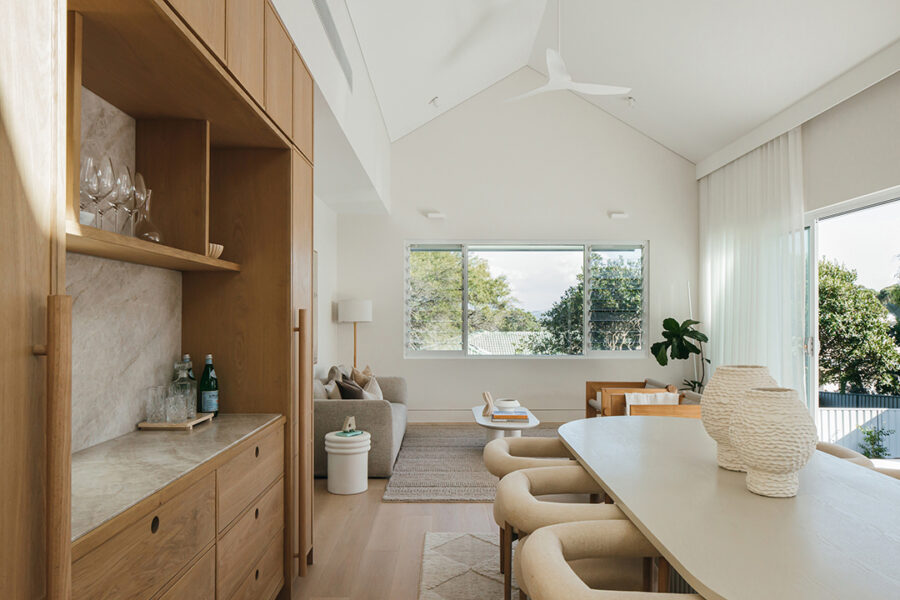
The Fanco Eco Style DC’s continuous airflow helps the interior of this Project feel welcoming, calm and healthy and supports the architectural goal of connecting indoor and outdoor spaces, and making both feel inviting and calming.
The Fanco Eco Style at the Sycamore Bateau Bay Project by Suburban Projects, Image: Grace Picot
Removing Stale Air and Improving Indoor Ventilation
Properly positioned ceiling fans can help draw fresh air through open windows or doorways and push it through the house. This steady airflow disperses particulate particles more effectively, reducing their concentration and preventing them from settling on surfaces, thus supporting healthy indoor air quality and reducing the buildup of indoor pollutants and allergens.
“Proper air circulation plays a critical role in enhancing the indoor air quality of Australian homes. Achieving optimal air circulation through the use of fans, vents, and other strategies offers numerous benefits, including improved indoor air quality.” – Alpha Air Australia
Over time, this can contribute to a fresher, healthier indoor environment by reducing the accumulation of airborne particles and odour-causing compounds and can aid in minimising the presence of allergens and pollutants, benefiting individuals with respiratory sensitivities – Especially in homes that lack mechanical ventilation systems.
Odour Control
Building on the previous benefit, the movement of air also helps to reduce lingering odours. Whether it’s from lingering kitchen smells, pet odours, sports equipment, or just a busy household, smells can accumulate — especially in homes where the air is stagnant. By keeping the air circulating, ceiling fans help to disperse these odours and reduce their impact, making your home feel fresher throughout the day.
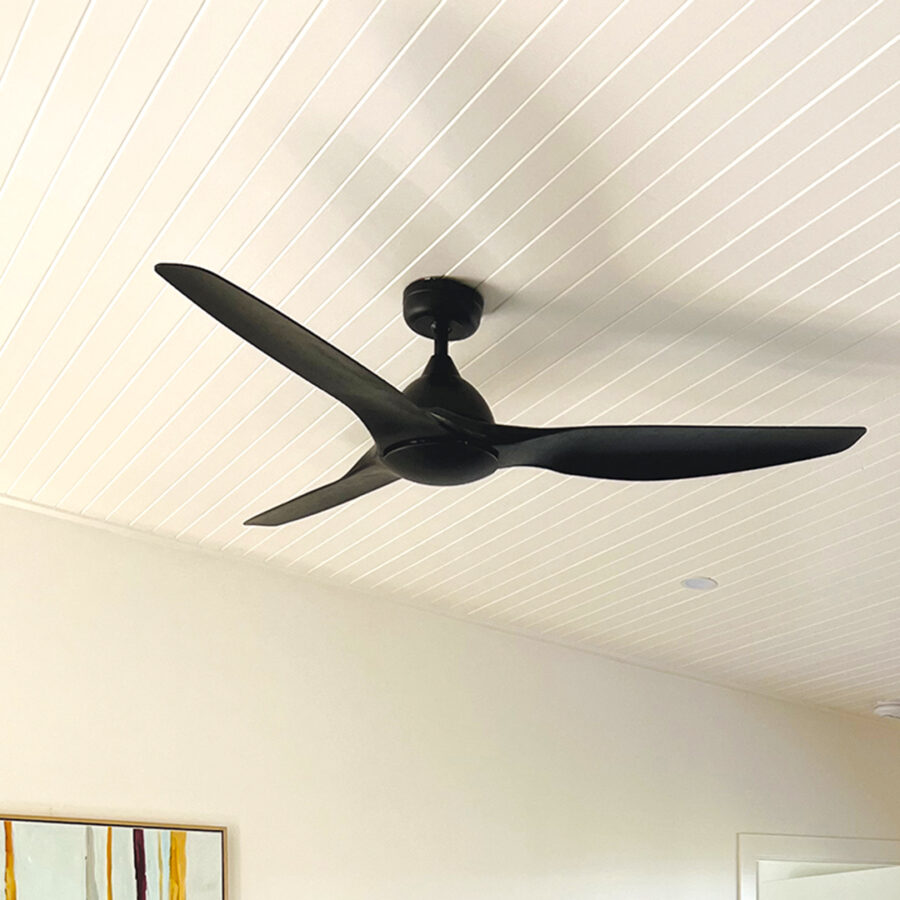
If left to run continuously the Fanco Horizon DC’s high airflow could be an ideal circulation solution for spaces of all types.
Using it’s Tri-Control technology the fan can be programmed to run automatically making it ideal for passive operations even when people are not home.
The Fanco Horizon DC, Image: Fanco
Addressing Common Concerns
Is It Bad to Leave a Ceiling Fan On All Day?
No, it’s not.
In fact, for most high-quality ceiling fan manufacturers continuous fan operation is an engineering consideration baked into the product’s design.
How Long Can a Ceiling Fan Run Continuously?
The question of “how many hours can a ceiling fan run continuously for?” is a surprisingly common one. When properly maintained ceiling fans can run continuously for thousands of hours. High-quality fans, especially those with energy-efficient DC motors, are engineered for these long-term operation and can be left running for seasons at a time. Fanco’s range are built with long product lifecycles in mind and are engineered to be used continuously for many hours at a time.
That said, it’s good practice to inspect your fan seasonally for signs of wear, and regular maintenance – such as cleaning the blades and ensuring the motor is free from dust – can significantly extend the lifespan of your fan.
When do I know my fan isn’t safe to leave running?
If your fan is installed correctly and running smoothly, it’s generally safe to leave to run continuously. However, ceiling fans tend to make it obvious when something’s wrong, and signs like unusual noises, visible wobbling, flickering lights, or sudden stops can indicate a fault. More serious warnings—such as a burning smell, visible smoke, or sparks—suggest a potential electrical issue.
If your fan shows any of these behaviours, switch it off at the power source and contact a qualified professional to inspect it before further use.

Leaving bedroom ceiling fans on continuously is an increasingly common behavior seen by Australian consumers. The Fanco Silent Deluxe as seen here in the Nightingale Fremantle Project can be left to run for months at a time – proving itself a valuable asset in the hot West Australian Summer.
The Fanco Eco Silent Deluxe DC at the Nightingale Fremantle Project by Nightingale Housing, Image: Kate Longley
Can Ceiling Fans Run Continuously Without Overheating?
Absolutely. High quality ceiling fans—particularly modern DC models—are engineered for continuous use, with motors designed to run efficiently and safely even in warm environments. Overheating is not a concern under normal operating conditions.
In the rare event of an electrical fault—such as an incorrect installation, power surge, or non-compliant power supply—the motor itself is typically not at risk. Instead, the fan’s internal receiver is designed to absorb the impact and fail safely well before the motor is ever compromised. In premium fans, like those in the Fanco range, this built-in safeguard ensures peace of mind even under extreme circumstances—though such electrical events remain uncommon in Australia.
“DC fans are equipped with a burnout prevention circuit that cuts the power to the windings or limits the current when the rotor is locked.” – Oriental Motor
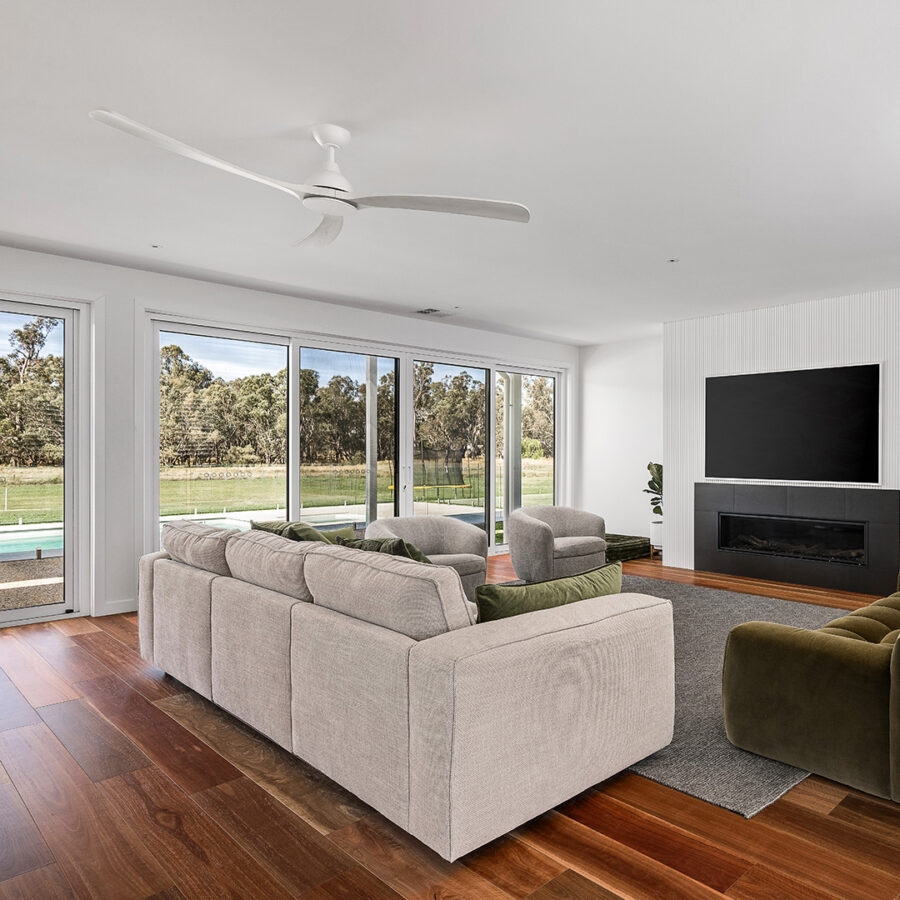
Larger Ceiling fans, like our Sanctuary DC seen here at the Lendamm Terrace Project, can act as a brilliant way to amplify the comfort of living room and entertainment spaces – and are able to be left to quietly operate for days at a time without issue
The Fanco Sanctuary DC seen in the Lendamm Terrace Project by Silimo constructions
What’s the cost of running a fan 24/7?
Unlike other electrical appliances, ceiling fans — especially modern DC motor models — consume very little energy when operating continuously for months.
Whilst low energy usage is a characteristic of just about every ceiling fan on the market, there are still some differences to be aware of – the most crucial being understanding the differences between AC and DC motors. Without going too in depth, ‘AC’ and ‘DC’ refer to ‘Alternating Current’ and ‘Direct Current’ motors within a ceiling fan. As stated previously, DC fans use ~70% less energy than their AC equivalents, which considering how little energy AC fans already use is an impressively small amount.
“In most cases, [DC ceiling fans] use less energy – up to 70% less than a standard AC fan.” – Universal Fans, AC vs DC Ceiling Fans, which ceiling fan is best?
At Fanco, energy efficiency is a priority for all our ceiling fan designs. We understand that energy costs can be a significant expense for many Australians and regularly prioritise low energy usage at the forefront of our ceiling fan designs. This has lead us to regularly make use of high-quality energy-efficient DC motors for our ceiling fans that draw as little as 1 to 30 watts of power depending on model and speed setting. You can see the operating costs of a Fanco Fan on its Product Page.
This means you can often run a ceiling fan 24/7 for less than the cost of a cup of coffee each month. When paired with the benefits to comfort and health as outlined before, and when combined with HVAC support, suddenly, ceiling fan’s low operating costs makes their continuous use an affordable and sustainable choice.
Why Fanco fans are ideal for continuous operation:
At Fanco we design our ceiling fans for Australian conditions, where airflow needs can vary dramatically between seasons and regions. Meeting these needs requires understanding of what Australian consumers airflow needs are, and innovation to meet those requirements. With market leading products like our sustainably minded and very-low-energy-usage EarthFirst range – which incorporates sustainable materials like FSC® certified timber blades and innovative new bio-based plastics – or our range of energy efficient DC Fans, our commitment to quality construction ensures our fans are engineered for longevity – longevity that allows our fans to be run continuously. Day or night. In any room in the home.
Designed for continuous operation, the EarthFirst Gaia DC is powered by a hyper-efficient DC motor that uses as little as 1–2 watts — less than a typical phone charger — while still circulating up to 5,493 m³/hr of air (54” model). This makes it a smart choice for energy-conscious homes and passive design strategies alike, offering high-performance airflow with minimal environmental impact.
Available in 52″ and 64″, the Horizon DC Fan pairs sculptural design with impressive airflow performance. The 64″ model moves up to 19,010 m³/hr, powered by a DC motor that uses just 4.9 watts at its lowest speed — ideal for continuous use in large living spaces or open-plan designs.
With low-speed airflow of 6,913 m³/hr, even minimal energy consumption delivers a meaningful cooling effect — all while using less energy than a standard LED bulb. A smart choice for wide coverage and efficiency without compromise.
Compact, quiet, and highly efficient, the Wynd DC fan is perfect for bedrooms and smaller spaces. Its energy-efficient DC motor uses as little as 1 watt — about the same as a digital alarm clock — while still circulating up to 4,642 m³/hr of air at low speed.
At full speed, the Wynd delivers up to 14,782 m³/hr — all with whisper-quiet operation and minimal energy impact. It’s an elegant solution for those who value performance, comfort, and low environmental footprint in equal measure.
Welcome to Fanco!
At Fanco, we’ve spent over a decade designing and delivering premium ceiling fans and ventilation solutions built for Australian homes and commercial spaces.
Every product we create reflects our commitment to innovation, quality, and sustainability—because great design should stand the test of time, and so should our planet.
It’s why we lead the market in forward-thinking design and customer support.




